Project Management: Analyzing Teamwork, Communication, and Diversity
VerifiedAdded on 2023/06/14
|17
|3750
|487
Report
AI Summary
This report explores the critical aspects of project management, focusing on teamwork, communication, and individual differences within the workplace. It highlights the significance of teamwork in fostering idea exchange and achieving organizational success, emphasizing the importance of positive corporate culture, employee recognition, and feedback. The report also delves into the role of communication in building trust, clarity, and collaboration among employees, examining various communication flows and their impact on organizational productivity. Furthermore, it addresses the concept of workplace diversity, discussing the challenges and opportunities arising from cultural and linguistic differences, and emphasizing the need for diversity management to maximize employee potential and contribution. The analysis draws from various journals and research to provide a comprehensive understanding of these key elements in project management and organizational behavior, providing insights that can be applied to improve work culture and organizational outcomes. Desklib offers a platform to explore similar solved assignments and project reports.
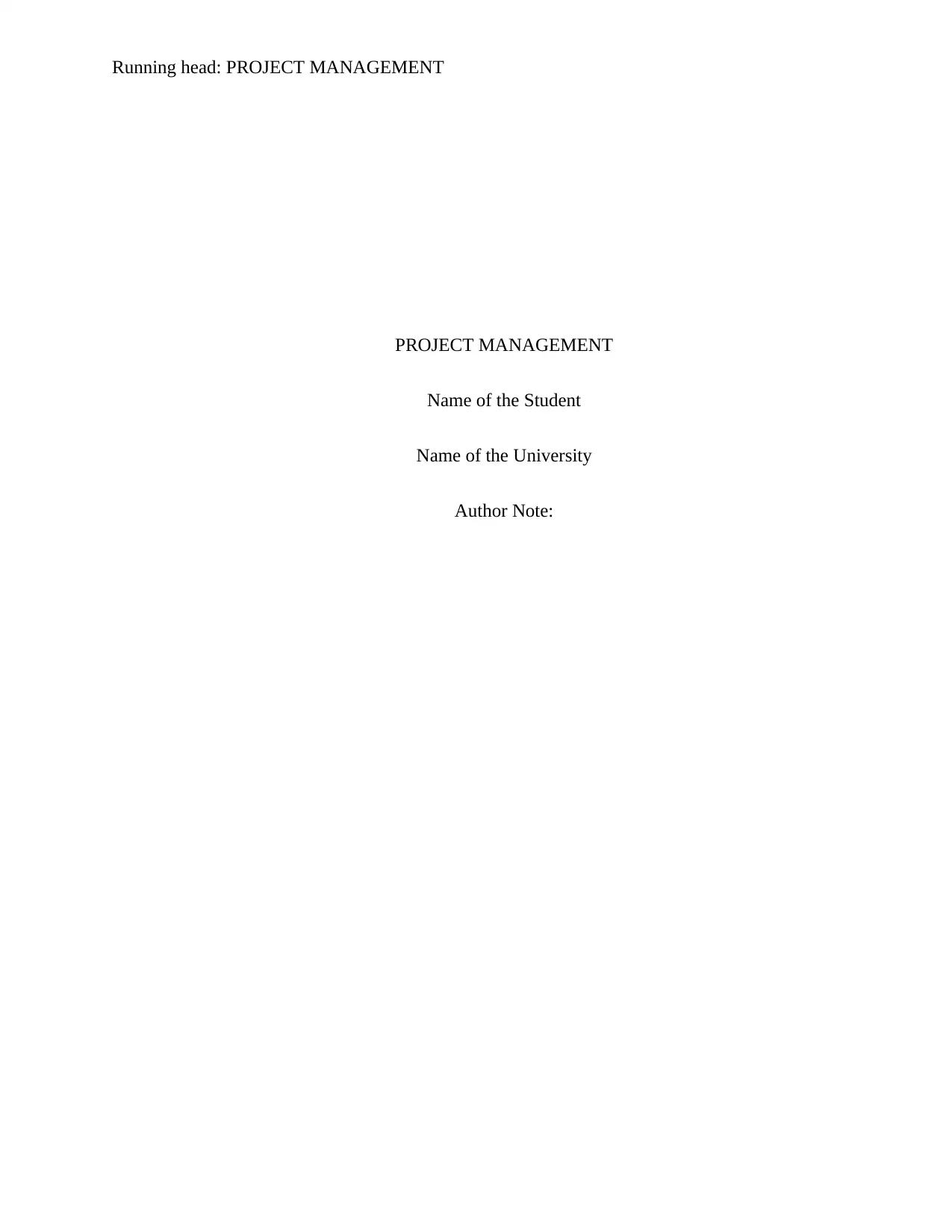
Running head: PROJECT MANAGEMENT
PROJECT MANAGEMENT
Name of the Student
Name of the University
Author Note:
PROJECT MANAGEMENT
Name of the Student
Name of the University
Author Note:
Paraphrase This Document
Need a fresh take? Get an instant paraphrase of this document with our AI Paraphraser
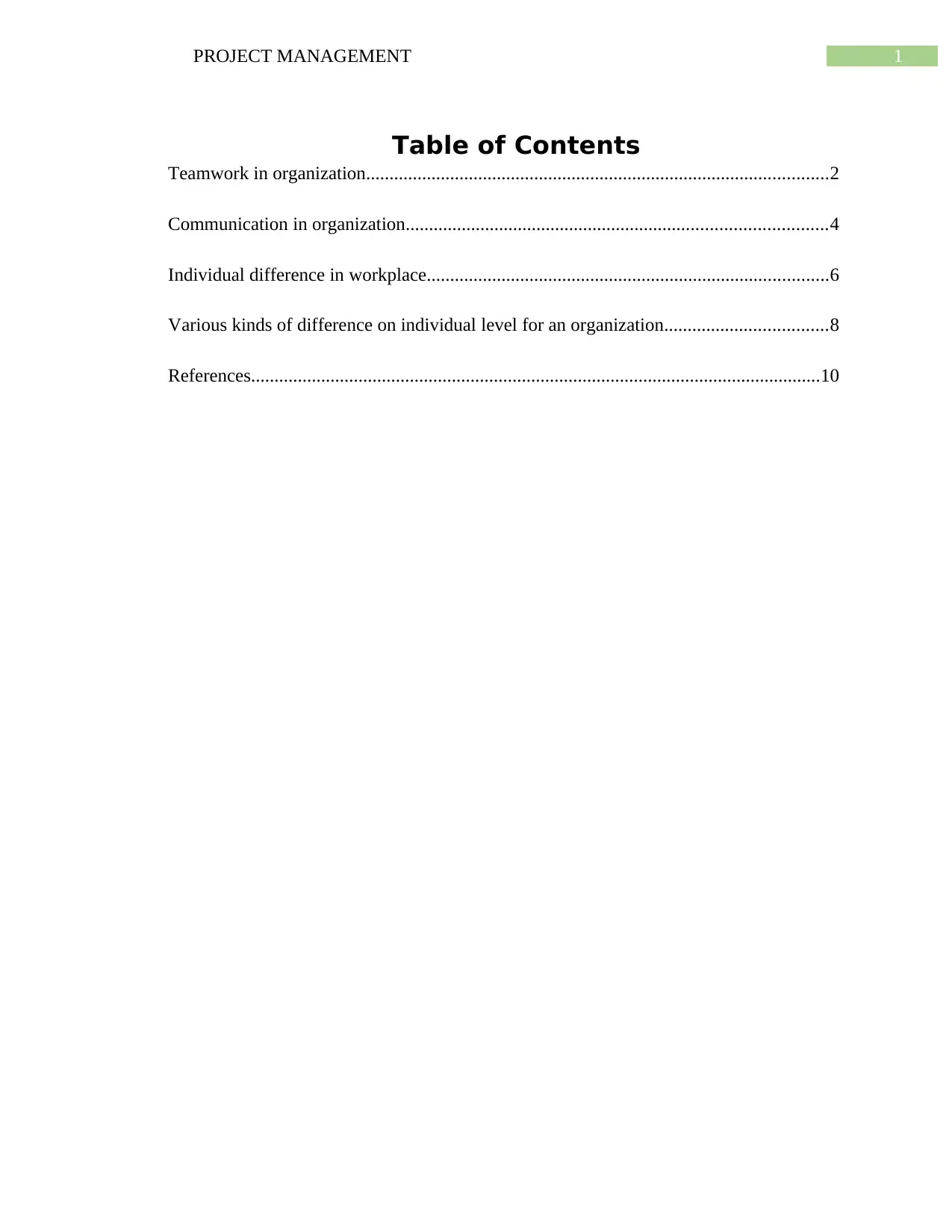
1PROJECT MANAGEMENT
Table of Contents
Teamwork in organization...................................................................................................2
Communication in organization..........................................................................................4
Individual difference in workplace......................................................................................6
Various kinds of difference on individual level for an organization...................................8
References..........................................................................................................................10
Table of Contents
Teamwork in organization...................................................................................................2
Communication in organization..........................................................................................4
Individual difference in workplace......................................................................................6
Various kinds of difference on individual level for an organization...................................8
References..........................................................................................................................10
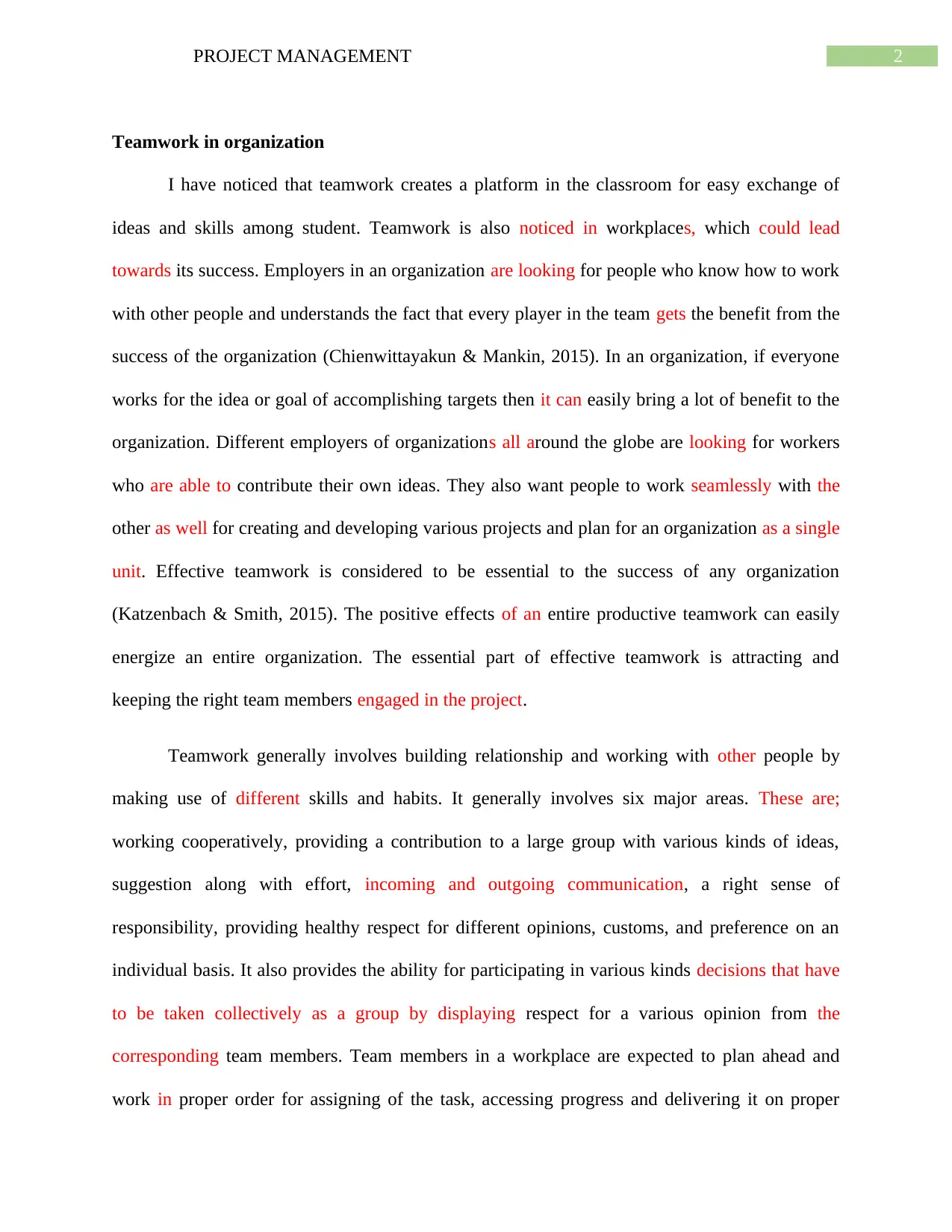
2PROJECT MANAGEMENT
Teamwork in organization
I have noticed that teamwork creates a platform in the classroom for easy exchange of
ideas and skills among student. Teamwork is also noticed in workplaces, which could lead
towards its success. Employers in an organization are looking for people who know how to work
with other people and understands the fact that every player in the team gets the benefit from the
success of the organization (Chienwittayakun & Mankin, 2015). In an organization, if everyone
works for the idea or goal of accomplishing targets then it can easily bring a lot of benefit to the
organization. Different employers of organizations all around the globe are looking for workers
who are able to contribute their own ideas. They also want people to work seamlessly with the
other as well for creating and developing various projects and plan for an organization as a single
unit. Effective teamwork is considered to be essential to the success of any organization
(Katzenbach & Smith, 2015). The positive effects of an entire productive teamwork can easily
energize an entire organization. The essential part of effective teamwork is attracting and
keeping the right team members engaged in the project.
Teamwork generally involves building relationship and working with other people by
making use of different skills and habits. It generally involves six major areas. These are;
working cooperatively, providing a contribution to a large group with various kinds of ideas,
suggestion along with effort, incoming and outgoing communication, a right sense of
responsibility, providing healthy respect for different opinions, customs, and preference on an
individual basis. It also provides the ability for participating in various kinds decisions that have
to be taken collectively as a group by displaying respect for a various opinion from the
corresponding team members. Team members in a workplace are expected to plan ahead and
work in proper order for assigning of the task, accessing progress and delivering it on proper
Teamwork in organization
I have noticed that teamwork creates a platform in the classroom for easy exchange of
ideas and skills among student. Teamwork is also noticed in workplaces, which could lead
towards its success. Employers in an organization are looking for people who know how to work
with other people and understands the fact that every player in the team gets the benefit from the
success of the organization (Chienwittayakun & Mankin, 2015). In an organization, if everyone
works for the idea or goal of accomplishing targets then it can easily bring a lot of benefit to the
organization. Different employers of organizations all around the globe are looking for workers
who are able to contribute their own ideas. They also want people to work seamlessly with the
other as well for creating and developing various projects and plan for an organization as a single
unit. Effective teamwork is considered to be essential to the success of any organization
(Katzenbach & Smith, 2015). The positive effects of an entire productive teamwork can easily
energize an entire organization. The essential part of effective teamwork is attracting and
keeping the right team members engaged in the project.
Teamwork generally involves building relationship and working with other people by
making use of different skills and habits. It generally involves six major areas. These are;
working cooperatively, providing a contribution to a large group with various kinds of ideas,
suggestion along with effort, incoming and outgoing communication, a right sense of
responsibility, providing healthy respect for different opinions, customs, and preference on an
individual basis. It also provides the ability for participating in various kinds decisions that have
to be taken collectively as a group by displaying respect for a various opinion from the
corresponding team members. Team members in a workplace are expected to plan ahead and
work in proper order for assigning of the task, accessing progress and delivering it on proper
⊘ This is a preview!⊘
Do you want full access?
Subscribe today to unlock all pages.

Trusted by 1+ million students worldwide
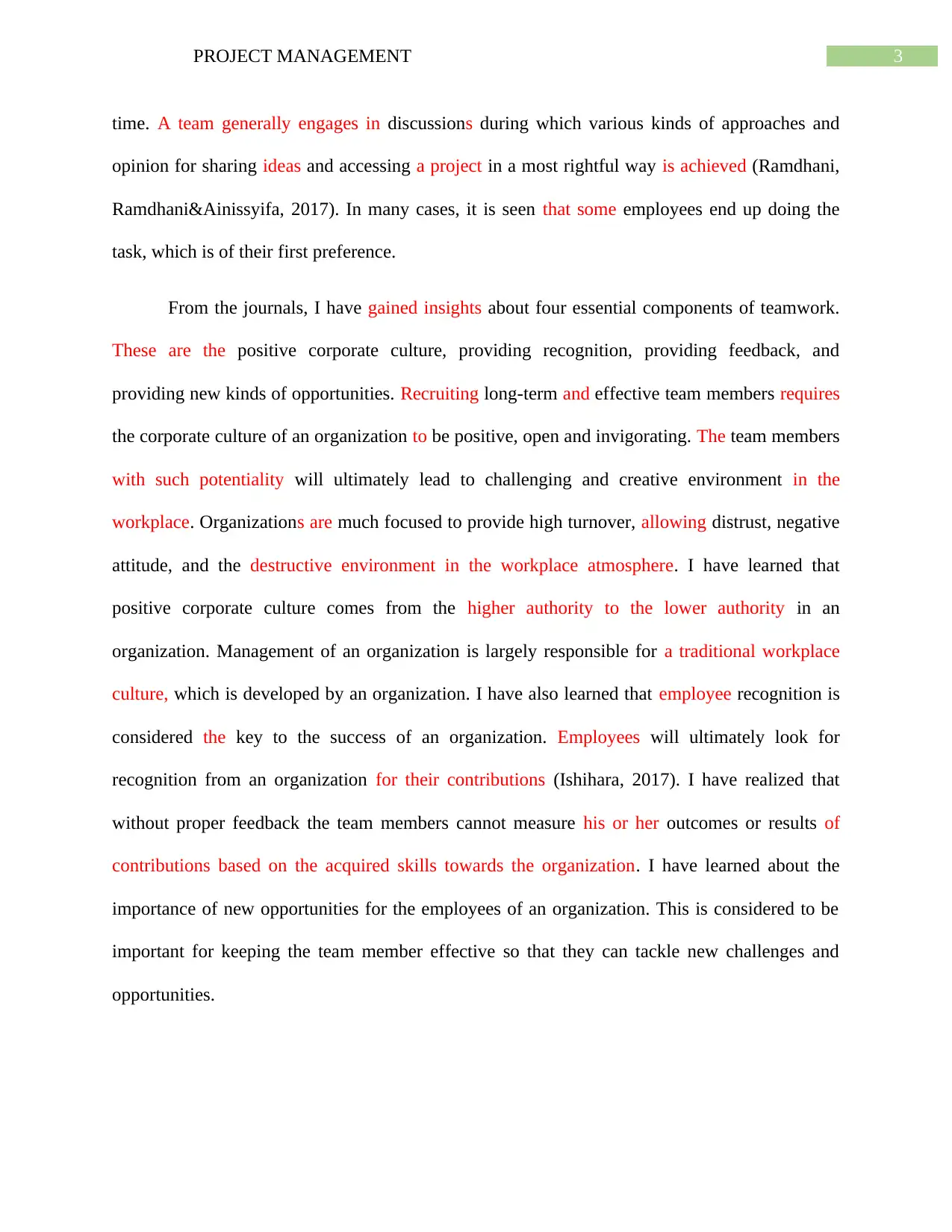
3PROJECT MANAGEMENT
time. A team generally engages in discussions during which various kinds of approaches and
opinion for sharing ideas and accessing a project in a most rightful way is achieved (Ramdhani,
Ramdhani&Ainissyifa, 2017). In many cases, it is seen that some employees end up doing the
task, which is of their first preference.
From the journals, I have gained insights about four essential components of teamwork.
These are the positive corporate culture, providing recognition, providing feedback, and
providing new kinds of opportunities. Recruiting long-term and effective team members requires
the corporate culture of an organization to be positive, open and invigorating. The team members
with such potentiality will ultimately lead to challenging and creative environment in the
workplace. Organizations are much focused to provide high turnover, allowing distrust, negative
attitude, and the destructive environment in the workplace atmosphere. I have learned that
positive corporate culture comes from the higher authority to the lower authority in an
organization. Management of an organization is largely responsible for a traditional workplace
culture, which is developed by an organization. I have also learned that employee recognition is
considered the key to the success of an organization. Employees will ultimately look for
recognition from an organization for their contributions (Ishihara, 2017). I have realized that
without proper feedback the team members cannot measure his or her outcomes or results of
contributions based on the acquired skills towards the organization. I have learned about the
importance of new opportunities for the employees of an organization. This is considered to be
important for keeping the team member effective so that they can tackle new challenges and
opportunities.
time. A team generally engages in discussions during which various kinds of approaches and
opinion for sharing ideas and accessing a project in a most rightful way is achieved (Ramdhani,
Ramdhani&Ainissyifa, 2017). In many cases, it is seen that some employees end up doing the
task, which is of their first preference.
From the journals, I have gained insights about four essential components of teamwork.
These are the positive corporate culture, providing recognition, providing feedback, and
providing new kinds of opportunities. Recruiting long-term and effective team members requires
the corporate culture of an organization to be positive, open and invigorating. The team members
with such potentiality will ultimately lead to challenging and creative environment in the
workplace. Organizations are much focused to provide high turnover, allowing distrust, negative
attitude, and the destructive environment in the workplace atmosphere. I have learned that
positive corporate culture comes from the higher authority to the lower authority in an
organization. Management of an organization is largely responsible for a traditional workplace
culture, which is developed by an organization. I have also learned that employee recognition is
considered the key to the success of an organization. Employees will ultimately look for
recognition from an organization for their contributions (Ishihara, 2017). I have realized that
without proper feedback the team members cannot measure his or her outcomes or results of
contributions based on the acquired skills towards the organization. I have learned about the
importance of new opportunities for the employees of an organization. This is considered to be
important for keeping the team member effective so that they can tackle new challenges and
opportunities.
Paraphrase This Document
Need a fresh take? Get an instant paraphrase of this document with our AI Paraphraser
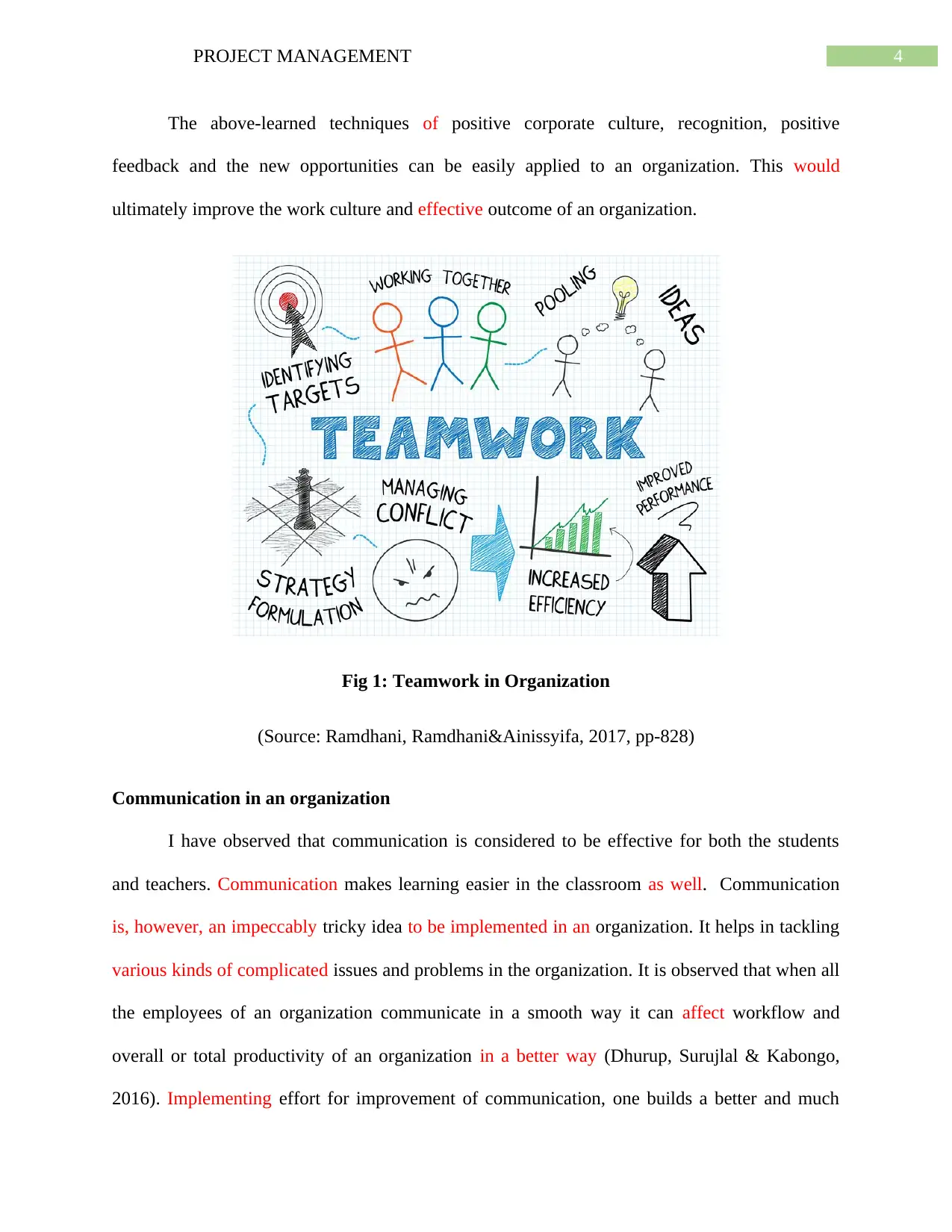
4PROJECT MANAGEMENT
The above-learned techniques of positive corporate culture, recognition, positive
feedback and the new opportunities can be easily applied to an organization. This would
ultimately improve the work culture and effective outcome of an organization.
Fig 1: Teamwork in Organization
(Source: Ramdhani, Ramdhani&Ainissyifa, 2017, pp-828)
Communication in an organization
I have observed that communication is considered to be effective for both the students
and teachers. Communication makes learning easier in the classroom as well. Communication
is, however, an impeccably tricky idea to be implemented in an organization. It helps in tackling
various kinds of complicated issues and problems in the organization. It is observed that when all
the employees of an organization communicate in a smooth way it can affect workflow and
overall or total productivity of an organization in a better way (Dhurup, Surujlal & Kabongo,
2016). Implementing effort for improvement of communication, one builds a better and much
The above-learned techniques of positive corporate culture, recognition, positive
feedback and the new opportunities can be easily applied to an organization. This would
ultimately improve the work culture and effective outcome of an organization.
Fig 1: Teamwork in Organization
(Source: Ramdhani, Ramdhani&Ainissyifa, 2017, pp-828)
Communication in an organization
I have observed that communication is considered to be effective for both the students
and teachers. Communication makes learning easier in the classroom as well. Communication
is, however, an impeccably tricky idea to be implemented in an organization. It helps in tackling
various kinds of complicated issues and problems in the organization. It is observed that when all
the employees of an organization communicate in a smooth way it can affect workflow and
overall or total productivity of an organization in a better way (Dhurup, Surujlal & Kabongo,
2016). Implementing effort for improvement of communication, one builds a better and much
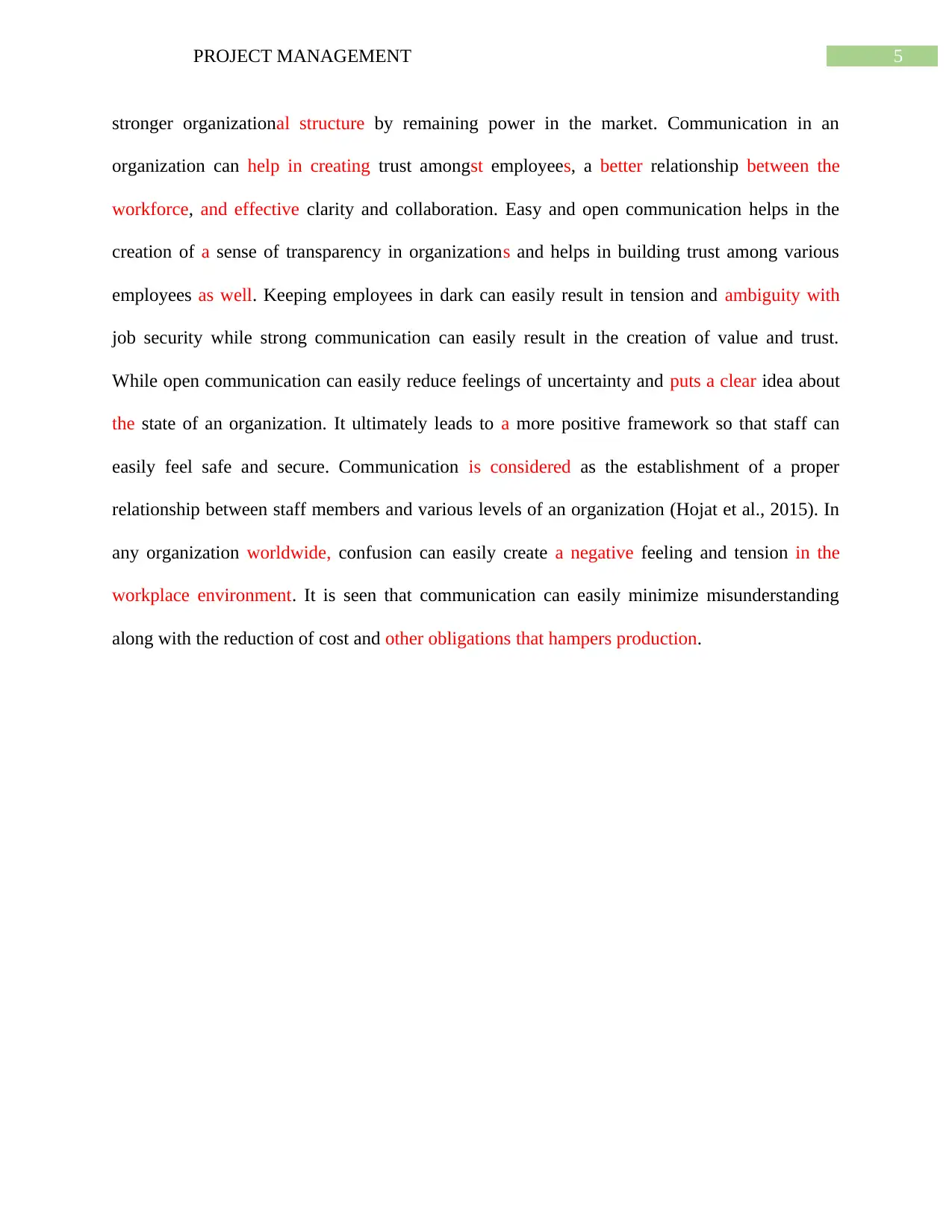
5PROJECT MANAGEMENT
stronger organizational structure by remaining power in the market. Communication in an
organization can help in creating trust amongst employees, a better relationship between the
workforce, and effective clarity and collaboration. Easy and open communication helps in the
creation of a sense of transparency in organizations and helps in building trust among various
employees as well. Keeping employees in dark can easily result in tension and ambiguity with
job security while strong communication can easily result in the creation of value and trust.
While open communication can easily reduce feelings of uncertainty and puts a clear idea about
the state of an organization. It ultimately leads to a more positive framework so that staff can
easily feel safe and secure. Communication is considered as the establishment of a proper
relationship between staff members and various levels of an organization (Hojat et al., 2015). In
any organization worldwide, confusion can easily create a negative feeling and tension in the
workplace environment. It is seen that communication can easily minimize misunderstanding
along with the reduction of cost and other obligations that hampers production.
stronger organizational structure by remaining power in the market. Communication in an
organization can help in creating trust amongst employees, a better relationship between the
workforce, and effective clarity and collaboration. Easy and open communication helps in the
creation of a sense of transparency in organizations and helps in building trust among various
employees as well. Keeping employees in dark can easily result in tension and ambiguity with
job security while strong communication can easily result in the creation of value and trust.
While open communication can easily reduce feelings of uncertainty and puts a clear idea about
the state of an organization. It ultimately leads to a more positive framework so that staff can
easily feel safe and secure. Communication is considered as the establishment of a proper
relationship between staff members and various levels of an organization (Hojat et al., 2015). In
any organization worldwide, confusion can easily create a negative feeling and tension in the
workplace environment. It is seen that communication can easily minimize misunderstanding
along with the reduction of cost and other obligations that hampers production.
⊘ This is a preview!⊘
Do you want full access?
Subscribe today to unlock all pages.

Trusted by 1+ million students worldwide
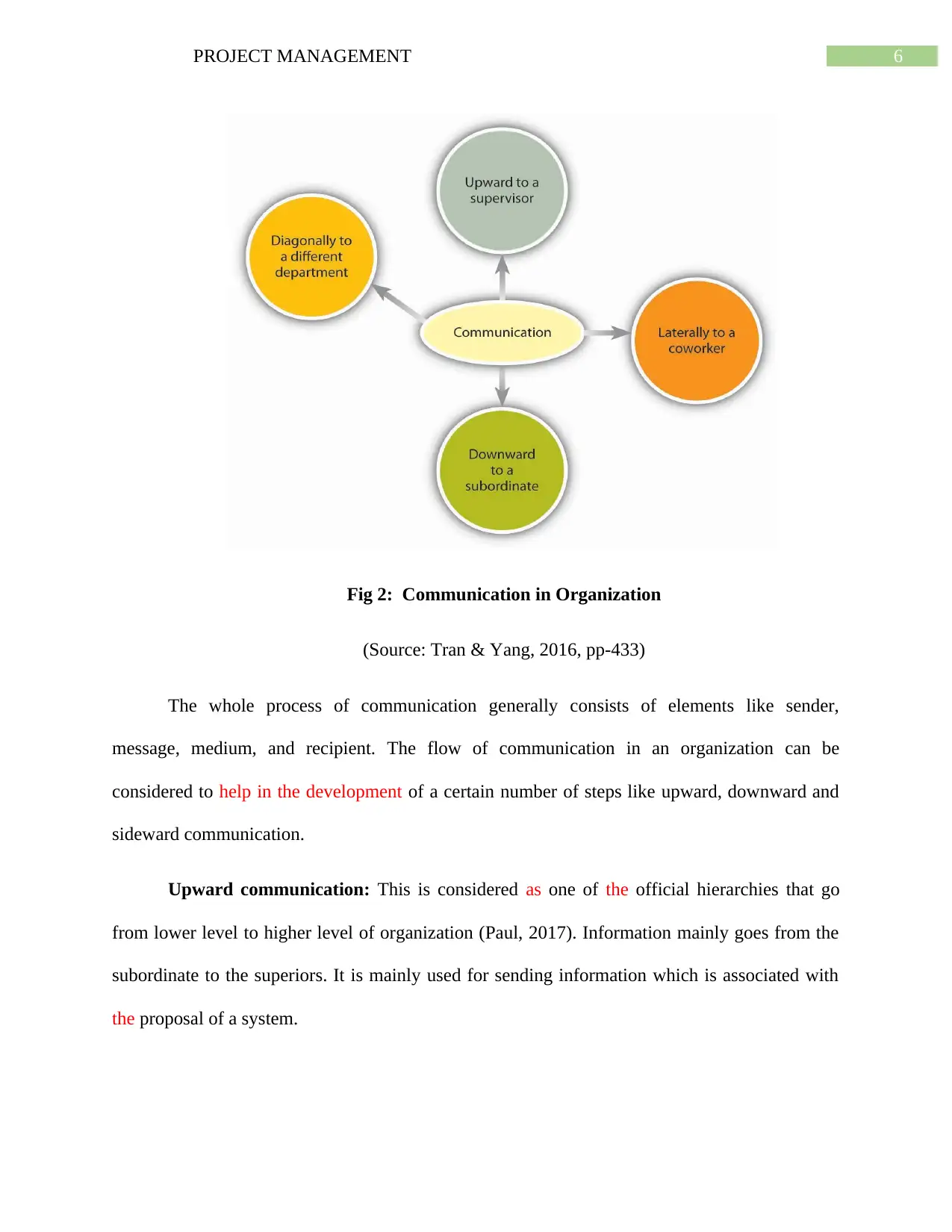
6PROJECT MANAGEMENT
Fig 2: Communication in Organization
(Source: Tran & Yang, 2016, pp-433)
The whole process of communication generally consists of elements like sender,
message, medium, and recipient. The flow of communication in an organization can be
considered to help in the development of a certain number of steps like upward, downward and
sideward communication.
Upward communication: This is considered as one of the official hierarchies that go
from lower level to higher level of organization (Paul, 2017). Information mainly goes from the
subordinate to the superiors. It is mainly used for sending information which is associated with
the proposal of a system.
Fig 2: Communication in Organization
(Source: Tran & Yang, 2016, pp-433)
The whole process of communication generally consists of elements like sender,
message, medium, and recipient. The flow of communication in an organization can be
considered to help in the development of a certain number of steps like upward, downward and
sideward communication.
Upward communication: This is considered as one of the official hierarchies that go
from lower level to higher level of organization (Paul, 2017). Information mainly goes from the
subordinate to the superiors. It is mainly used for sending information which is associated with
the proposal of a system.
Paraphrase This Document
Need a fresh take? Get an instant paraphrase of this document with our AI Paraphraser
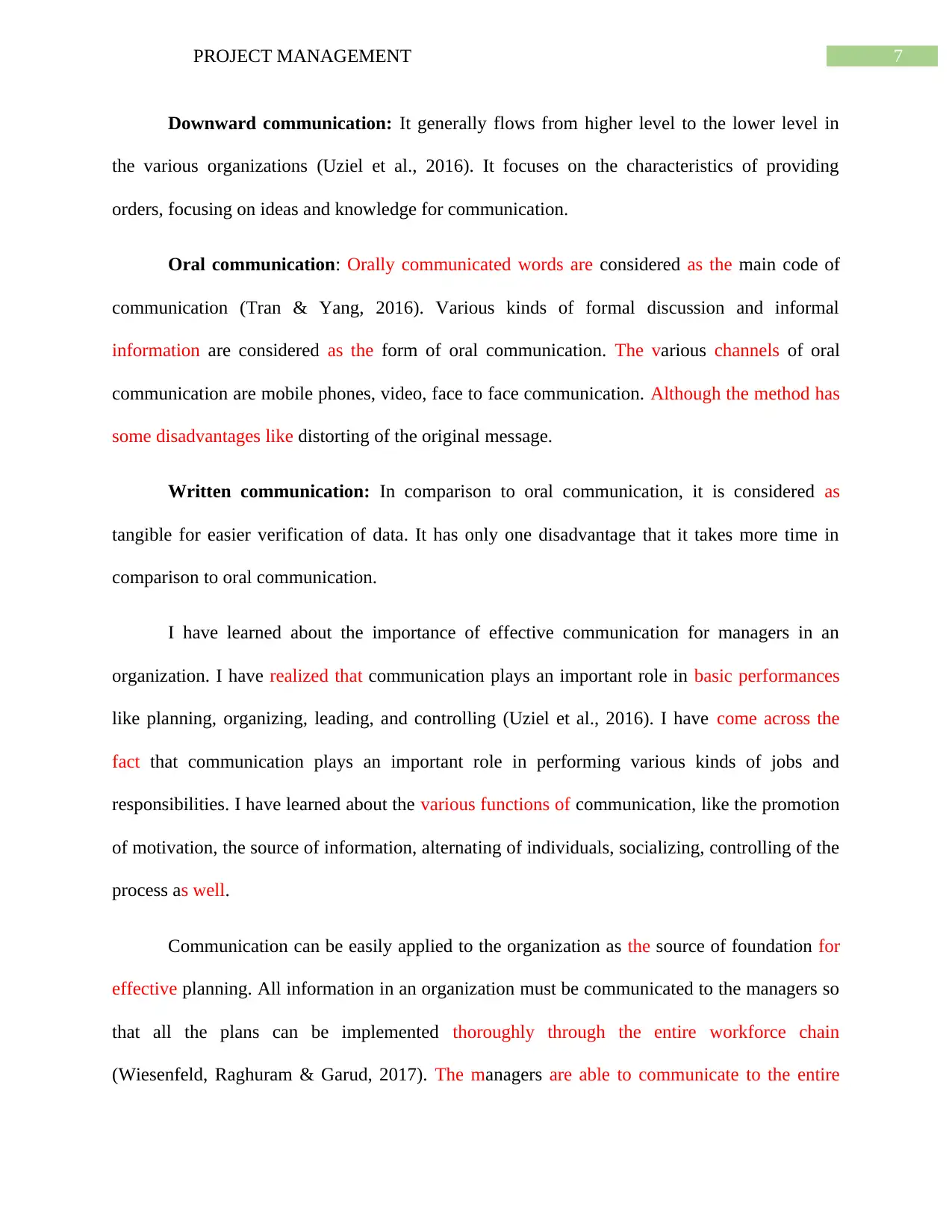
7PROJECT MANAGEMENT
Downward communication: It generally flows from higher level to the lower level in
the various organizations (Uziel et al., 2016). It focuses on the characteristics of providing
orders, focusing on ideas and knowledge for communication.
Oral communication: Orally communicated words are considered as the main code of
communication (Tran & Yang, 2016). Various kinds of formal discussion and informal
information are considered as the form of oral communication. The various channels of oral
communication are mobile phones, video, face to face communication. Although the method has
some disadvantages like distorting of the original message.
Written communication: In comparison to oral communication, it is considered as
tangible for easier verification of data. It has only one disadvantage that it takes more time in
comparison to oral communication.
I have learned about the importance of effective communication for managers in an
organization. I have realized that communication plays an important role in basic performances
like planning, organizing, leading, and controlling (Uziel et al., 2016). I have come across the
fact that communication plays an important role in performing various kinds of jobs and
responsibilities. I have learned about the various functions of communication, like the promotion
of motivation, the source of information, alternating of individuals, socializing, controlling of the
process as well.
Communication can be easily applied to the organization as the source of foundation for
effective planning. All information in an organization must be communicated to the managers so
that all the plans can be implemented thoroughly through the entire workforce chain
(Wiesenfeld, Raghuram & Garud, 2017). The managers are able to communicate to the entire
Downward communication: It generally flows from higher level to the lower level in
the various organizations (Uziel et al., 2016). It focuses on the characteristics of providing
orders, focusing on ideas and knowledge for communication.
Oral communication: Orally communicated words are considered as the main code of
communication (Tran & Yang, 2016). Various kinds of formal discussion and informal
information are considered as the form of oral communication. The various channels of oral
communication are mobile phones, video, face to face communication. Although the method has
some disadvantages like distorting of the original message.
Written communication: In comparison to oral communication, it is considered as
tangible for easier verification of data. It has only one disadvantage that it takes more time in
comparison to oral communication.
I have learned about the importance of effective communication for managers in an
organization. I have realized that communication plays an important role in basic performances
like planning, organizing, leading, and controlling (Uziel et al., 2016). I have come across the
fact that communication plays an important role in performing various kinds of jobs and
responsibilities. I have learned about the various functions of communication, like the promotion
of motivation, the source of information, alternating of individuals, socializing, controlling of the
process as well.
Communication can be easily applied to the organization as the source of foundation for
effective planning. All information in an organization must be communicated to the managers so
that all the plans can be implemented thoroughly through the entire workforce chain
(Wiesenfeld, Raghuram & Garud, 2017). The managers are able to communicate to the entire
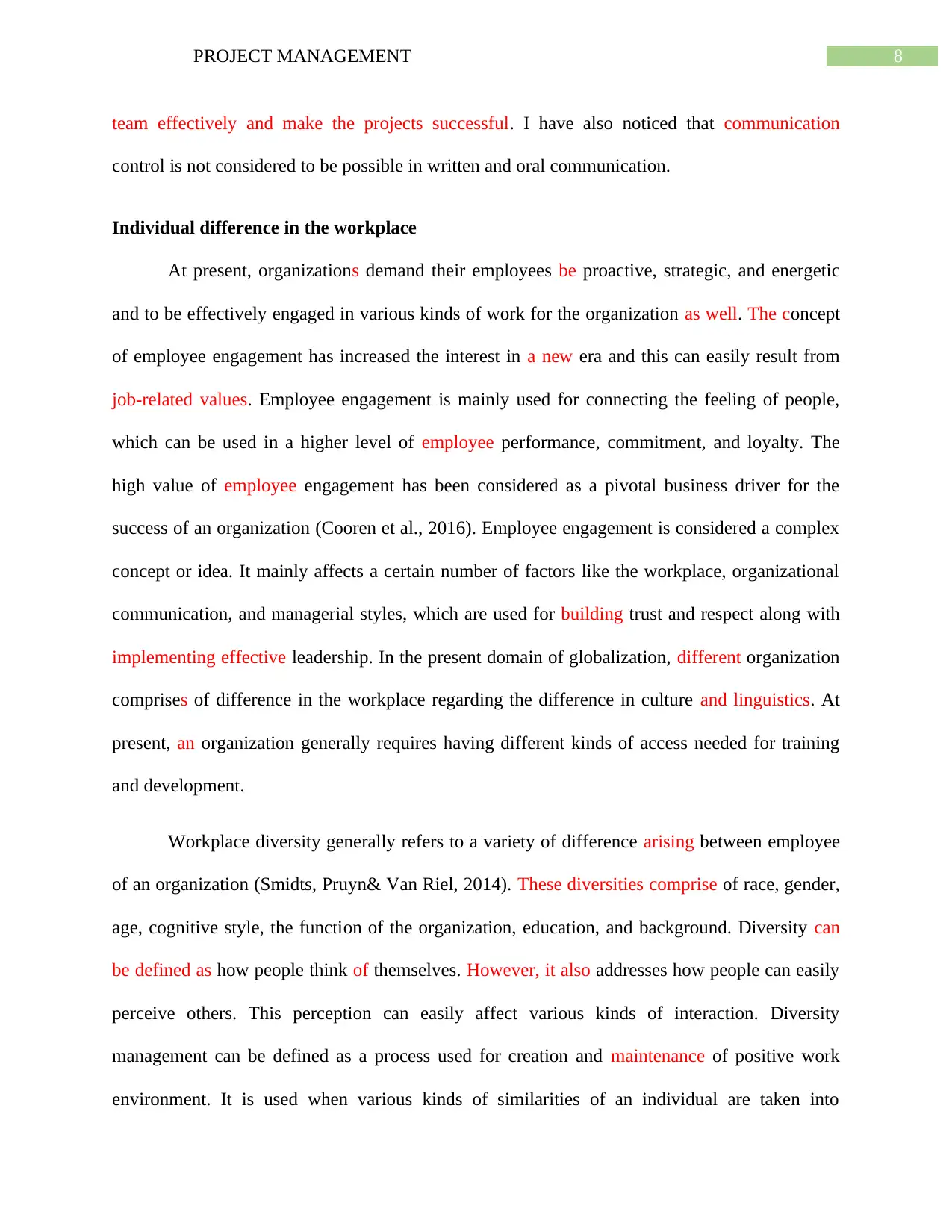
8PROJECT MANAGEMENT
team effectively and make the projects successful. I have also noticed that communication
control is not considered to be possible in written and oral communication.
Individual difference in the workplace
At present, organizations demand their employees be proactive, strategic, and energetic
and to be effectively engaged in various kinds of work for the organization as well. The concept
of employee engagement has increased the interest in a new era and this can easily result from
job-related values. Employee engagement is mainly used for connecting the feeling of people,
which can be used in a higher level of employee performance, commitment, and loyalty. The
high value of employee engagement has been considered as a pivotal business driver for the
success of an organization (Cooren et al., 2016). Employee engagement is considered a complex
concept or idea. It mainly affects a certain number of factors like the workplace, organizational
communication, and managerial styles, which are used for building trust and respect along with
implementing effective leadership. In the present domain of globalization, different organization
comprises of difference in the workplace regarding the difference in culture and linguistics. At
present, an organization generally requires having different kinds of access needed for training
and development.
Workplace diversity generally refers to a variety of difference arising between employee
of an organization (Smidts, Pruyn& Van Riel, 2014). These diversities comprise of race, gender,
age, cognitive style, the function of the organization, education, and background. Diversity can
be defined as how people think of themselves. However, it also addresses how people can easily
perceive others. This perception can easily affect various kinds of interaction. Diversity
management can be defined as a process used for creation and maintenance of positive work
environment. It is used when various kinds of similarities of an individual are taken into
team effectively and make the projects successful. I have also noticed that communication
control is not considered to be possible in written and oral communication.
Individual difference in the workplace
At present, organizations demand their employees be proactive, strategic, and energetic
and to be effectively engaged in various kinds of work for the organization as well. The concept
of employee engagement has increased the interest in a new era and this can easily result from
job-related values. Employee engagement is mainly used for connecting the feeling of people,
which can be used in a higher level of employee performance, commitment, and loyalty. The
high value of employee engagement has been considered as a pivotal business driver for the
success of an organization (Cooren et al., 2016). Employee engagement is considered a complex
concept or idea. It mainly affects a certain number of factors like the workplace, organizational
communication, and managerial styles, which are used for building trust and respect along with
implementing effective leadership. In the present domain of globalization, different organization
comprises of difference in the workplace regarding the difference in culture and linguistics. At
present, an organization generally requires having different kinds of access needed for training
and development.
Workplace diversity generally refers to a variety of difference arising between employee
of an organization (Smidts, Pruyn& Van Riel, 2014). These diversities comprise of race, gender,
age, cognitive style, the function of the organization, education, and background. Diversity can
be defined as how people think of themselves. However, it also addresses how people can easily
perceive others. This perception can easily affect various kinds of interaction. Diversity
management can be defined as a process used for creation and maintenance of positive work
environment. It is used when various kinds of similarities of an individual are taken into
⊘ This is a preview!⊘
Do you want full access?
Subscribe today to unlock all pages.

Trusted by 1+ million students worldwide
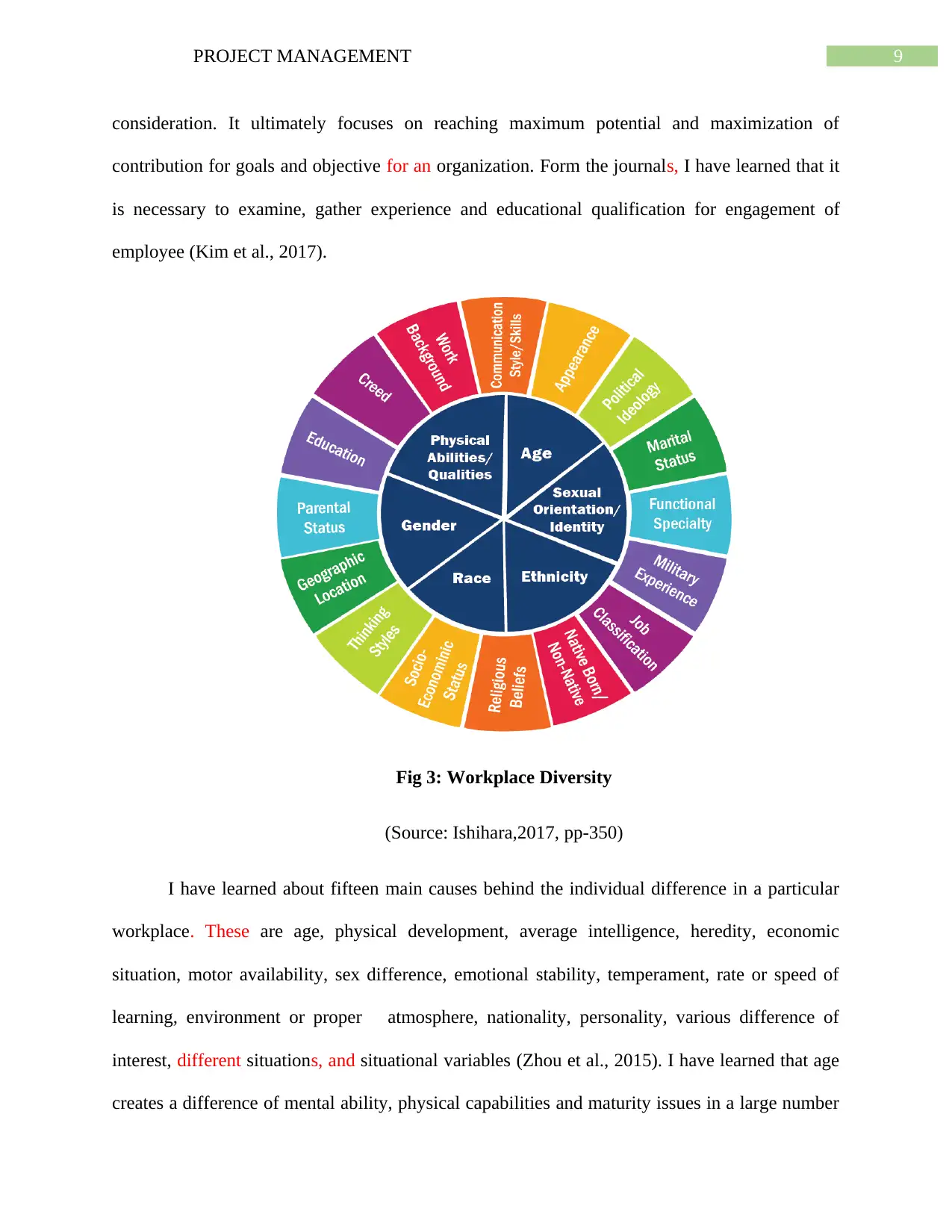
9PROJECT MANAGEMENT
consideration. It ultimately focuses on reaching maximum potential and maximization of
contribution for goals and objective for an organization. Form the journals, I have learned that it
is necessary to examine, gather experience and educational qualification for engagement of
employee (Kim et al., 2017).
Fig 3: Workplace Diversity
(Source: Ishihara,2017, pp-350)
I have learned about fifteen main causes behind the individual difference in a particular
workplace. These are age, physical development, average intelligence, heredity, economic
situation, motor availability, sex difference, emotional stability, temperament, rate or speed of
learning, environment or proper atmosphere, nationality, personality, various difference of
interest, different situations, and situational variables (Zhou et al., 2015). I have learned that age
creates a difference of mental ability, physical capabilities and maturity issues in a large number
consideration. It ultimately focuses on reaching maximum potential and maximization of
contribution for goals and objective for an organization. Form the journals, I have learned that it
is necessary to examine, gather experience and educational qualification for engagement of
employee (Kim et al., 2017).
Fig 3: Workplace Diversity
(Source: Ishihara,2017, pp-350)
I have learned about fifteen main causes behind the individual difference in a particular
workplace. These are age, physical development, average intelligence, heredity, economic
situation, motor availability, sex difference, emotional stability, temperament, rate or speed of
learning, environment or proper atmosphere, nationality, personality, various difference of
interest, different situations, and situational variables (Zhou et al., 2015). I have learned that age
creates a difference of mental ability, physical capabilities and maturity issues in a large number
Paraphrase This Document
Need a fresh take? Get an instant paraphrase of this document with our AI Paraphraser
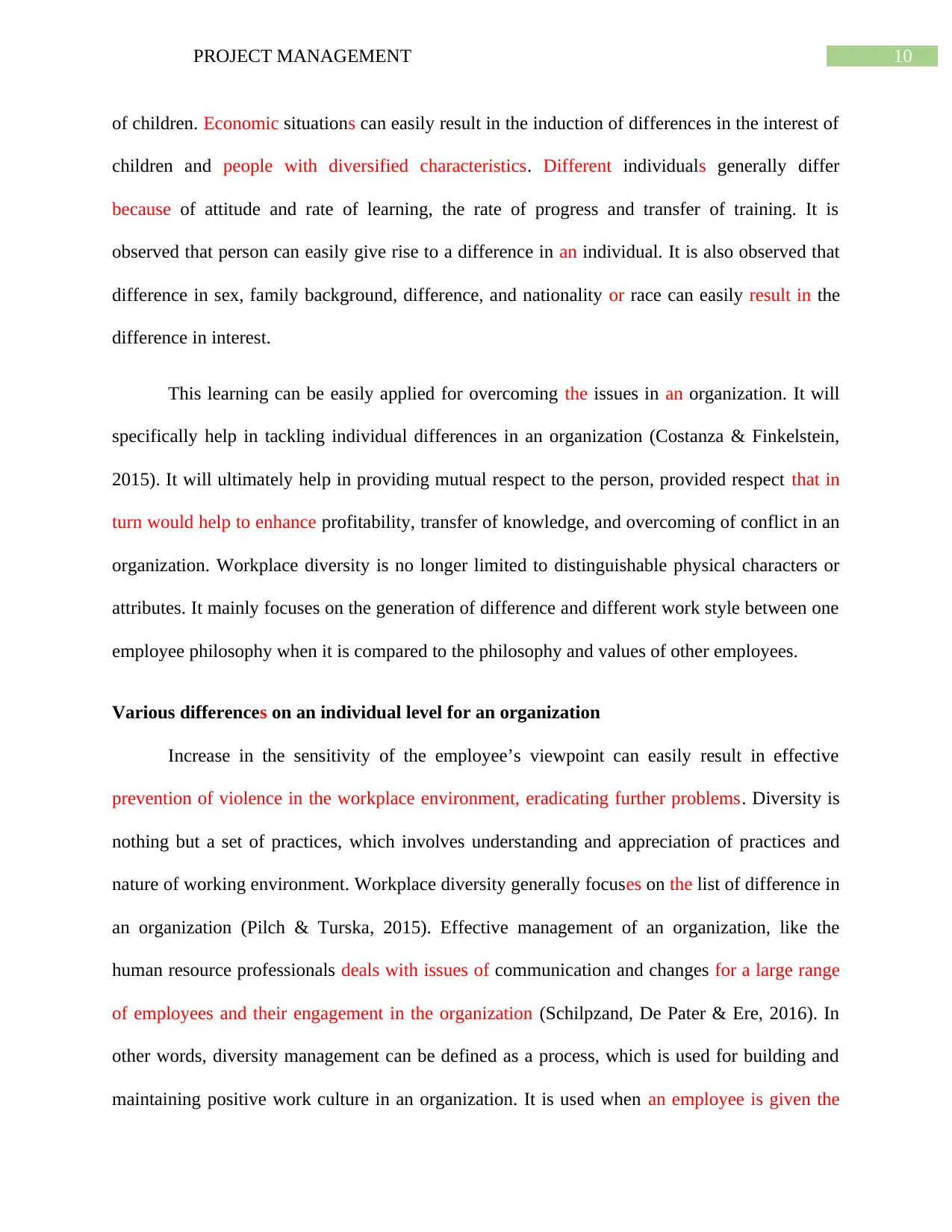
10PROJECT MANAGEMENT
of children. Economic situations can easily result in the induction of differences in the interest of
children and people with diversified characteristics. Different individuals generally differ
because of attitude and rate of learning, the rate of progress and transfer of training. It is
observed that person can easily give rise to a difference in an individual. It is also observed that
difference in sex, family background, difference, and nationality or race can easily result in the
difference in interest.
This learning can be easily applied for overcoming the issues in an organization. It will
specifically help in tackling individual differences in an organization (Costanza & Finkelstein,
2015). It will ultimately help in providing mutual respect to the person, provided respect that in
turn would help to enhance profitability, transfer of knowledge, and overcoming of conflict in an
organization. Workplace diversity is no longer limited to distinguishable physical characters or
attributes. It mainly focuses on the generation of difference and different work style between one
employee philosophy when it is compared to the philosophy and values of other employees.
Various differences on an individual level for an organization
Increase in the sensitivity of the employee’s viewpoint can easily result in effective
prevention of violence in the workplace environment, eradicating further problems. Diversity is
nothing but a set of practices, which involves understanding and appreciation of practices and
nature of working environment. Workplace diversity generally focuses on the list of difference in
an organization (Pilch & Turska, 2015). Effective management of an organization, like the
human resource professionals deals with issues of communication and changes for a large range
of employees and their engagement in the organization (Schilpzand, De Pater & Ere, 2016). In
other words, diversity management can be defined as a process, which is used for building and
maintaining positive work culture in an organization. It is used when an employee is given the
of children. Economic situations can easily result in the induction of differences in the interest of
children and people with diversified characteristics. Different individuals generally differ
because of attitude and rate of learning, the rate of progress and transfer of training. It is
observed that person can easily give rise to a difference in an individual. It is also observed that
difference in sex, family background, difference, and nationality or race can easily result in the
difference in interest.
This learning can be easily applied for overcoming the issues in an organization. It will
specifically help in tackling individual differences in an organization (Costanza & Finkelstein,
2015). It will ultimately help in providing mutual respect to the person, provided respect that in
turn would help to enhance profitability, transfer of knowledge, and overcoming of conflict in an
organization. Workplace diversity is no longer limited to distinguishable physical characters or
attributes. It mainly focuses on the generation of difference and different work style between one
employee philosophy when it is compared to the philosophy and values of other employees.
Various differences on an individual level for an organization
Increase in the sensitivity of the employee’s viewpoint can easily result in effective
prevention of violence in the workplace environment, eradicating further problems. Diversity is
nothing but a set of practices, which involves understanding and appreciation of practices and
nature of working environment. Workplace diversity generally focuses on the list of difference in
an organization (Pilch & Turska, 2015). Effective management of an organization, like the
human resource professionals deals with issues of communication and changes for a large range
of employees and their engagement in the organization (Schilpzand, De Pater & Ere, 2016). In
other words, diversity management can be defined as a process, which is used for building and
maintaining positive work culture in an organization. It is used when an employee is given the
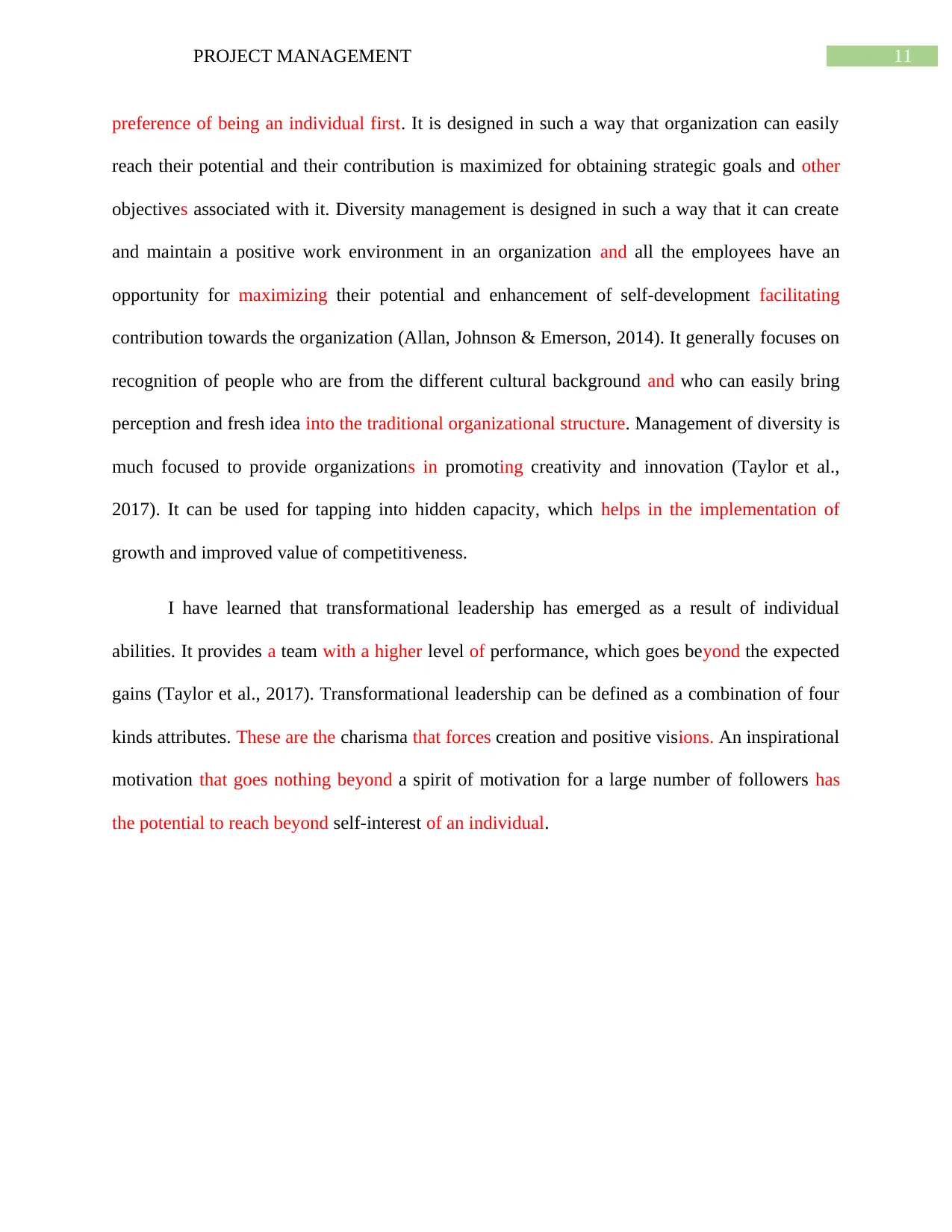
11PROJECT MANAGEMENT
preference of being an individual first. It is designed in such a way that organization can easily
reach their potential and their contribution is maximized for obtaining strategic goals and other
objectives associated with it. Diversity management is designed in such a way that it can create
and maintain a positive work environment in an organization and all the employees have an
opportunity for maximizing their potential and enhancement of self-development facilitating
contribution towards the organization (Allan, Johnson & Emerson, 2014). It generally focuses on
recognition of people who are from the different cultural background and who can easily bring
perception and fresh idea into the traditional organizational structure. Management of diversity is
much focused to provide organizations in promoting creativity and innovation (Taylor et al.,
2017). It can be used for tapping into hidden capacity, which helps in the implementation of
growth and improved value of competitiveness.
I have learned that transformational leadership has emerged as a result of individual
abilities. It provides a team with a higher level of performance, which goes beyond the expected
gains (Taylor et al., 2017). Transformational leadership can be defined as a combination of four
kinds attributes. These are the charisma that forces creation and positive visions. An inspirational
motivation that goes nothing beyond a spirit of motivation for a large number of followers has
the potential to reach beyond self-interest of an individual.
preference of being an individual first. It is designed in such a way that organization can easily
reach their potential and their contribution is maximized for obtaining strategic goals and other
objectives associated with it. Diversity management is designed in such a way that it can create
and maintain a positive work environment in an organization and all the employees have an
opportunity for maximizing their potential and enhancement of self-development facilitating
contribution towards the organization (Allan, Johnson & Emerson, 2014). It generally focuses on
recognition of people who are from the different cultural background and who can easily bring
perception and fresh idea into the traditional organizational structure. Management of diversity is
much focused to provide organizations in promoting creativity and innovation (Taylor et al.,
2017). It can be used for tapping into hidden capacity, which helps in the implementation of
growth and improved value of competitiveness.
I have learned that transformational leadership has emerged as a result of individual
abilities. It provides a team with a higher level of performance, which goes beyond the expected
gains (Taylor et al., 2017). Transformational leadership can be defined as a combination of four
kinds attributes. These are the charisma that forces creation and positive visions. An inspirational
motivation that goes nothing beyond a spirit of motivation for a large number of followers has
the potential to reach beyond self-interest of an individual.
⊘ This is a preview!⊘
Do you want full access?
Subscribe today to unlock all pages.

Trusted by 1+ million students worldwide
1 out of 17
Related Documents
Your All-in-One AI-Powered Toolkit for Academic Success.
+13062052269
info@desklib.com
Available 24*7 on WhatsApp / Email
![[object Object]](/_next/static/media/star-bottom.7253800d.svg)
Unlock your academic potential
Copyright © 2020–2025 A2Z Services. All Rights Reserved. Developed and managed by ZUCOL.




